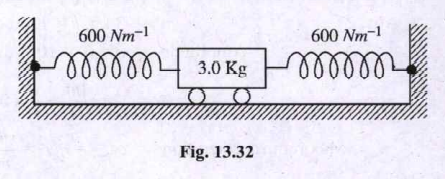Complete Solutions to ADDITIONAL SOLVED PROBLEMS of chapter OSCILLATIONS of Class 11 book with complete answers and questions
| Class 11 | PHYSICS |
| Chapter | OSCILLATIONS |
| S CHAND | ADDITIONAL SOLVED PROBLEMS |
| Number Of Questions | 11 |
| Academic Year | 2023-24 |
Figures below show four different spring arrangements. If the mass in each arrangement is displaced from its equilibrium position and released, what is the resulting frequency of vibration in each case ? Neglect the mass of the each spring. (See Fig).
 05:27View Solution
05:27View SolutionFigure (a) shows a spring of force constant k clamped rigidly at one end and a mass attached to its free end. The spring is stretched by a force F at its free end. Figure (b) shows the same spring with both ends free and attached to a mass m at either end. Each end of the spring in Fig.(b) is stretched by the same force F.
(i) What is the maximum extension of spring in the two cases?
If the mass in (a) and the two masses in (b) are released free, what is the period of oscillation in each case ?
 04:38View Solution
04:38View SolutionA spring of force constant `1200 Nm^(-1)` is mounted on a horizontal table as shown in Fig. A mass of 3.0 kg is attached to the free end of spring, pulled sideways to a distance of 2.0 cm and released.
(a) What is the frequency of oscillation of mass ?
(b) What is its maximum acceleration ?
(c) What is its maximum speed ?
 02:56View Solution
02:56View SolutionA tray of mass 12 kg is supported by a two identical springs as shown in Fig. When the tray is pressed down slightly and released it executes shm with a period of 1.5 s. What is the force constant of each spring ? When a block of mass m is placed on the tray, the period of shm changes to 3.0 s What is the mass of the block ?
 04:46View Solution
04:46View SolutionA trolley of mass 3.0 kg is connected to two identical springs each of force constant 600 Nm as shown in Fig. If the trolley is displaced from its equilibrium position by 5.0 cm and released, what is (a) period of oscillation, (b) the maximum speed of the trolley, (c) how much is the total energy dissipated as heat by the time the trolley comes to rest due to damping force ?
 03:55View Solution
03:55View SolutionA trolley of mass `3.0 kg` is connected to two identical springs each of force constant `600 Nm^(-1)`as shown in figure 13.32 (amplitude=5cm)

Problem (a) period of oscillation
Problem (b) the max speed of trolley.
If the spring in the problem are replaced by rubber bands, what is the answer to the question (a) and (b) in the problem if `K` of rubber band is `600 Nm^(-1)` during extensions.View SolutionTwo vibrating bodies have frequencies 10 Hz and 12 Hz. They start oscillating in the sáme phase. In 3 seconds how many time they will be (i) in the same phase and (ii) in the opposite phase ?
02:03View SolutionA 3 kg collar attached to a spring of force constant `1200 Nm^(-1)` slides without friction on a horizontal rod. The collar is displaced from its equilibrium position by 6.0 cm and released. Calculate (a) the period of oscillation, (b) the maximum magnitude of acceleration and (c) the maximum speed of collar. (Fig)
 03:16View Solution
03:16View SolutionIf the earth were a homogeneous sphere of radius R and a straight hole bored in it through its centre, show that a particle dropped into the hole will execute shm and find out its period.
05:14View SolutionA particle is moving with shm in a straight line. When the distance of the particle from the equilibrium position has the value `x_1 and x_2` the corresponding values of velocities are `v_1 and v_2` show that period is `T=2pi[(x_2^2-x_1^2)/(v_1^2-v_2^2)]^(1//2)`
06:42View SolutionThe acceleration due to gravity on the surface of moon is `1.7 ms^(-2)` . What is the time period of a simple pendulum on the moon if its time period on the earth is 3.5 s ? (g on earth = `9.8 ms^(-2)`)
02:58View Solution
ADDITIONAL SOLVED PROBLEMS questions and complete solutions for chapter OSCILLATIONS of S CHAND PHYSICS (ENGLISH) of Class 11
All Exercises from S CHAND Class 11 PHYSICS OSCILLATIONS
- ADDITIONAL SOLVED PROBLEMS
- LONG ANSWER QUESTIONS
- SELECTED PROBLEMS (FROM ENERGY OF AS.H. OSCILLATOR )
- SELECTED PROBLEMS (FROM THE CHARACTERISTIC OF SHM)
- SELECTED PROBLEMS (FROM TIME PERIOD OF OSCILLATION OF A S.H. OSCILLATOR)
- SELECTED PROBLEMS (OSCILLATION IN A TUNNEL BORED THROUGH THE EARTH)
- SELECTED PROBLEMS (PERIOD OF OSCILLATION OF (i) A LIQUID IN A U-TUBE, (ii) TEST TUBE FLOAT, (iii) (iii) A PISTON IN AN ENGINE etc.)
- SHORT ANSWER QUESTIONS
- SHORT ANSWER QUESTIONS WITH ANSWER
- SOLVED EXAMPLE
- VERY SHORT ANSWER QUESTIONS
